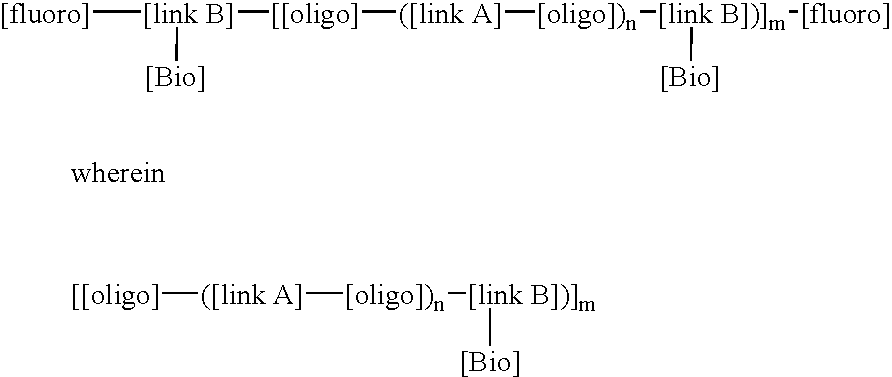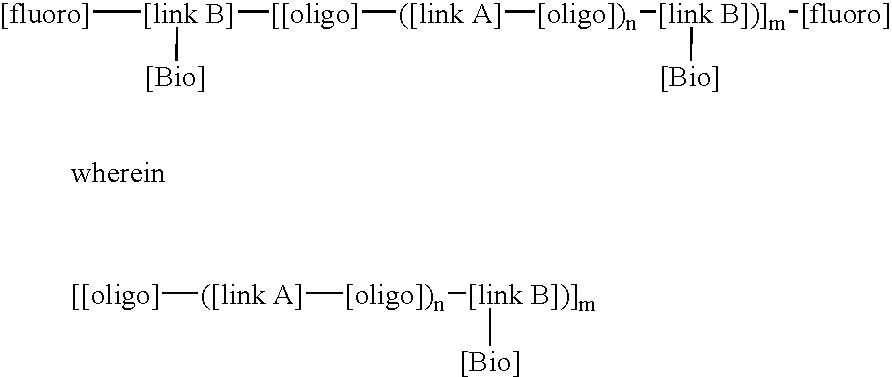Bioactive surface modifiers for polymers and articles made therefrom
- Summary
- Abstract
- Description
- Claims
- Application Information
AI Technical Summary
Benefits of technology
Problems solved by technology
Method used
Image
Examples
example 1
LDI / PCN / I / VITE is an example of a BFSM according to the invention which contains a high fluorine content and a pendent vitamin-E molecule coupled adjacent to the fluorine tails of the BFSM such that the molecule can reduce the inflammatory stimulated response of the oxidant HOCl (hypochlorous acid). In addition, this BFSM can contribute to enhancing the biocompatible nature of the polymer surface, in which the BFSM is added, with the interfacing biological environment, specifically reducing the ability of inflammatory cell derived oxidants to degrade polymer surfaces. LDI / PCN / I / VITE was synthesized with lysine diisocyanate as both the linkA and linkB molecules, polycarbonate diol (molecular weight of 970), (PCN) was use as the oligo component, fraction (I) of the fluoroalcohol BA-L was used as the [fluoro] component and vitamin-E was used as the [Bio] component. This BFSM will be referred to as. LDI / PCN / I / VITE, throughout this text. The conditions of synthesis for this reaction are ...
example 2
LDI / PTMO / I / HEP is an example of a BFSM with a stoichiometry that introduces a fluorine content of 5 wt % and pendent Heparin (molecule weight 3000, procured from Sigma Chemicals, St Louis) molecules coupled adjacent to the fluorine tails of the BFSM such that the molecule can catalyse the deactivation of thrombin (in key protein involved in the upregulation of clot formation) via anti-thrombin III (a key inhibitor of the clot forming process) at the surface of the polymer. In addition, this BFSM can contribute to enhancing the biocompatible nature of the polymer surface, in which the BFSM is added to, with the interfacing biological environment, specifically reducing the potential for blood to form uncontrolled thrombus growth on a biomaterial surface and generate subsequent embolization events. LDI / PTMO / I / HEP was synthesized with lysine diisocyanate as both the linkA and linkB reactants, polytetramethylene oxide diol (molecular weight of 1000) as the oligo component, fraction (I) o...
example 3
LDI / PCN / I / NORF is an example of a BFSM with a stoichiometry that introduces a fluorine content of approximately 10 wt % and pendent Norfloxacin molecules a broad spectrum fluoroquinolone anti-microbial agent moieties coupled adjacent to the fluorine tails of the BFSM such that the [Bio] component can provide an antimicrobial agent to the surface of the polymer to control the activity of bacteria, such as, for example, P. aeruginosa or E. coli, to minimize infection. In addition, this BFSM can contribute to enhancing the biocompatible nature of the polymer surface, in which the BFSM is added, with the interfacing biological environment, specifically reducing the potential for bacteria to form biofilms which ultimately leads to the removal of the implant. LDI / PCN / I / NORF was synthesized with lysine diisocyanate as both the linkA and linkB reactants, polycarbonate diol (molecular weight of 970) was used as the oligo component, fraction (I) of the fluoroalcohol BA-L was used as the fluor...
PUM
| Property | Measurement | Unit |
|---|---|---|
| contact angle | aaaaa | aaaaa |
| pressure | aaaaa | aaaaa |
| temperature | aaaaa | aaaaa |
Abstract
Description
Claims
Application Information
 Login to View More
Login to View More - R&D
- Intellectual Property
- Life Sciences
- Materials
- Tech Scout
- Unparalleled Data Quality
- Higher Quality Content
- 60% Fewer Hallucinations
Browse by: Latest US Patents, China's latest patents, Technical Efficacy Thesaurus, Application Domain, Technology Topic, Popular Technical Reports.
© 2025 PatSnap. All rights reserved.Legal|Privacy policy|Modern Slavery Act Transparency Statement|Sitemap|About US| Contact US: help@patsnap.com



